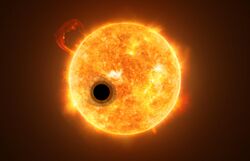Astronomy:WASP-107b
 Artist's impression of exoplanet WASP-107b.[1] | |
| Discovery | |
|---|---|
| Discovered by | D. R. Anderson et al. |
| Discovery date | 2017 |
| WASP-South | |
| Orbital characteristics | |
| 0.0566 ± 0.0017 AU (8,470,000 ± 250,000 km)[2] | |
| Eccentricity | 0[3] |
| Orbital period | 5.7214742 d[2] |
| Star | WASP-107 |
| Physical characteristics | |
| Mean radius | 0.96±0.03 |♃|J}}}}}}[2] |
WASP-107b is a super-Neptune exoplanet that orbits the star WASP-107. It lies 200 light-years away from Earth in the constellation Virgo.[4] Its discovery was announced in 2017 by a team led by D. R. Anderson via the WASP-South.[5]
Planetary orbit
WASP-107b could not have formed in its current orbit. It likely migrated inward from its birth orbit beyond 1 AU due to interaction with the heavier planet WASP-107c. It is in a retrograde orbit, strongly misaligned with the equatorial plane of the parent star. The misalignment angle is equal to 118°+38−19.[6] WASP-107c follows a highly eccentric and inclined orbit with a period of 1088+15−16 days.[2]
Physical characteristics
WASP-107b is a super-Neptune ice giant exoplanet located 200 light years away from Earth in the constellation Virgo.[4] It is roughly the size of Jupiter but less than one-tenth of Jupiter's mass, making it one of the lowest density exoplanets.[2] Its radius is 0.96±0.03 times Jupiter's, making its atmosphere fluffy, and coupled with transiting a moderately bright K-type star, makes it a target for atmospheric characterization.[7] It is eight times nearer to its star than Mercury is to the Sun and orbits its star every 5.7 days.[4] With a temperature of 500 °C (932 °F), its atmosphere makes it one of the hottest known exoplanets.[4]
Helium was discovered in the planet's atmosphere in 2018, making it the first time helium was discovered on an exoplanet.[8] A follow-up observation with Keck in 2020 showed that the helium absorption extends beyond transit-egress.[9] Extreme ultraviolet radiation from the host star is gradually whittling down the planet's atmosphere, forming a comet-like tail 7 times as long as the radius of the planet.[10][11]
In November 2023, scientists discovered that its atmosphere contains water vapor and sulfur dioxide. The clouds on this planet are made up of silicates.[12][13]
See also
References
- ↑ heic1809 (2 May 2018). "Hubble detects helium in the atmosphere of an exoplanet for the first time". https://www.spacetelescope.org/news/heic1809/.
- ↑ 2.0 2.1 2.2 2.3 2.4 Cite error: Invalid
<ref>tag; no text was provided for refs namedPiaulet2020 - ↑ "Planet WASP-107 b". Extrasolar Planets Encyclopaedia. 2017. https://exoplanet.eu/catalog/wasp_107_b--6505/.
- ↑ 4.0 4.1 4.2 4.3 Reed, Nola (2 May 2018). "An Exoplanet First! Helium Spotted on Bizarre Comet-Like World". https://www.space.com/40469-helium-detected-alien-planet-atmosphere.html.
- ↑ Anderson, D.R. et al. (August 2017). "The discoveries of WASP-91b, WASP-105b and WASP-107b: Two warm Jupiters and a planet in the transition region between ice giants and gas giants". Astronomy & Astrophysics 604 (A110): A110. doi:10.1051/0004-6361/201730439. Bibcode: 2017A&A...604A.110A. https://www.aanda.org/articles/aa/pdf/2017/08/aa30439-17.pdf.
- ↑ Rubenzahl, Ryan A.; Dai, Fei; Howard, Andrew W.; Chontos, Ashley; Giacalone, Steven; Lubin, Jack; Rosenthal, Lee J.; Isaacson, Howard et al. (2021), "The TESS–Keck Survey. IV. A Retrograde, Polar Orbit for the Ultra-low-density, Hot Super-Neptune WASP-107b", The Astronomical Journal 161 (3): 119, doi:10.3847/1538-3881/abd177, Bibcode: 2021AJ....161..119R
- ↑ "First results on the atmosphere of WASP-107b". Wide Angle Search for Planets. September 27, 2017. https://wasp-planets.net/2017/09/27/first-results-on-the-atmosphere-of-wasp-107b/.
- ↑ Witze, Alexandra (2 May 2018). "Astronomers spot helium on exoplanet for first time". Nature. doi:10.1038/d41586-018-05052-w. https://www.nature.com/articles/d41586-018-05052-w.
- ↑ Kirk, James; Alam, Munazza K.; Lopez-Morales, Mercedes; Zeng, Li (2020-01-21). "Confirmation of WASP-107b's extended Helium atmosphere with Keck II/NIRSPEC". The Astronomical Journal 159 (3): 115. doi:10.3847/1538-3881/ab6e66. Bibcode: 2020AJ....159..115K.
- ↑ waspplanets (2020-01-22). "Helium reveals the extended atmosphere of WASP-107b" (in en). https://wasp-planets.net/2020/01/22/helium-reveals-the-extended-atmosphere-of-wasp-107b/.
- ↑ Spake, J. J.; Oklopčić, A.; Hillenbrand, L. A. (2021), "The Posttransit Tail of WASP-107b Observed at 10830 Å", The Astronomical Journal 162 (6): 284, doi:10.3847/1538-3881/ac178a, Bibcode: 2021AJ....162..284S
- ↑ "Clouds made of sand make for a strange kind of rain on this hot planet". https://www.npr.org/2023/11/15/1213159944/clouds-made-of-sand-make-for-a-strange-kind-of-rain-on-this-hot-planet.
- ↑ Dyrek, Achrène; Min, Michiel; Decin, Leen; Bouwman, Jeroen; Crouzet, Nicolas; Mollière, Paul; Lagage, Pierre-Olivier; Konings, Thomas et al. (2023-11-15). "SO2, silicate clouds, but no CH4 detected in a warm Neptune" (in en). Nature: 1–3. doi:10.1038/s41586-023-06849-0. ISSN 0028-0836. PMID 37967578. https://www.nature.com/articles/s41586-023-06849-0.
External links
 |



